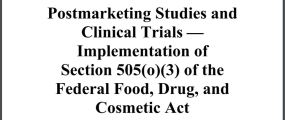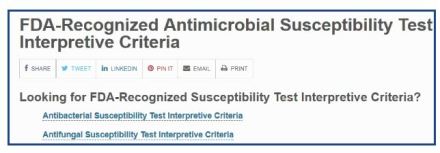FDA BRIEF: Weeks of Dec 4 and Dec 11, 2017
New Tool for Sharing Information that Allows Doctors to Better Manage Antibiotic Use; Improve Patient Care
Antimicrobial resistance one of most pressing public health challenges
- Policy efforts to encourage new drug development, limit use in livestock
- New steps for appropriate use in patient care; part of Cures Act
New Tool – Antimicrobial Susceptibility Test (AST) results to select appropriate antibacterial/antifungal drug for treatment
- Tests rely on criteria — susceptibility test interpretive criteria or “breakpoints” — to help determine whether specific bacteria/fungi susceptible to antibacterial/ antifungal drugs
- Bacteria and fungi change over time decreasing susceptibility to some drugs
- Breakpoints updated accordingly – FDA-recognized breakpoints
- Drug manufacturers will have to update labeling to reference FDA web page containing breakpoint information
 Bringing Early Feasibility Studies for Medical Devices Back to the United States
Bringing Early Feasibility Studies for Medical Devices Back to the United States
Early Feasibility Studies Program (EFS) provides route for innovators, sponsors, FDA review teams, and clinicians to work together
- Facilitate early clinical evaluation of medical devices in US
- Limited clinical study in early development, typically before final device design
- Evaluate device design concept with respect to initial safety and functionality
- The EFS Program includes enhanced opportunities for collaboration, increased regulatory flexibility, and consideration of benefit-risk principles, while maintaining appropriate patient protection measures
IDEs submitted for EFS has more than doubled
- Most studies receive timely FDA approval
- Support device innovation and enhance early patient access to new technologies
Sponsor resources: MDIC EFS working groups, Early Feasibility Studies Webpage
 Advancing New Digital Health Policies to Encourage Innovation, Bring Efficiency and Modernization to Regulation
Advancing New Digital Health Policies to Encourage Innovation, Bring Efficiency and Modernization to Regulation
Three new, significant policy documents to advance development and proper oversight of innovative digital health tools
- To support consumers and health care providers increasingly embracing digital health technologies to inform everyday decisions
- Consumers makes more efficient decisions, improve lifestyles, health choices, and often experience better outcomes
- Regulatory approach must foster, not inhibit, innovation; enhance access
- Strike the right balance between ensuring patient safety and promoting innovation
(1) Draft guidance: Clinical and Patient Decision Support Software – CDS and PDS
- Types of CDS would no longer be defined as medical device
- Allows provider to independently review basis for recommendations
- Will enforce oversight of software programs
- Intended to process or analyze medical images, Signals from in vitro diagnostic devices, Patterns acquired from a processor e.g. ECG
- Not enforce oversight for lower-risk PDS
- Should follow a similar regulatory structure as CDS
- However, software that does not allow independent review of recommendation subject to FDA active oversight
(2) Draft guidance: Changes to Existing Medical Software Policies
- Digital health provisions included in Section 3060 of Cures Act
- FDA’s interpretation of types of software no longer considered medical devices
- Low risk to patients, but provide great value to consumers
- Update guidances on General Wellness and Mobile Medical Applications
(3) Final Guidance: Software as a Medical Device: Clinical Evaluation– SaMD
- Harmonization with International Medical Device Regulators Forum (IMDRF)
- Globally recognized principles in evaluating safety, effectiveness and performance
 FDA-Required Post-Marketing Studies of Approved Drugs Make a Big Difference for Public Health
FDA-Required Post-Marketing Studies of Approved Drugs Make a Big Difference for Public Health
Certain drug issues need additional evaluation after approval
- to confirm clinical benefit when approved under accelerated approval provisions
- further evaluation of potential safety issue
- better characterize risk factors for known safety issue
FDA Amendments Act of 2007 (FDAAA) requires post-marketing requirements (PMRs) and post-marketing commitments (PMC) when new safety information
- Committed to making sure industry fulfills PMRs and PMCs
- Public availability in a searchable database
- Annual Federal Register (FR) report
- Informs Congress on status and “backlog”
Advancing Policies to Promote Safe, Effective MedTech Innovation
Voluntary, alternative pathway for demonstrating substantial equivalence for 510(k) premarket notifications
- More flexibility to use more modern criteria as reference standard
- Permit comparisons to standards that more closely approximate the novel technology
Make review process more benefit-risk based
- Adopt more modern tools for evaluating safety and benefits of new products
- Embed patient-centric measures of risk and benefit
New Steps to Reform, Modernize 510(k) Review
- Include FDA-recognized standards, FDA-developed guidance documents, or a combination of the two
- For pre-specified categories of mature devices
- Review framework to conform to international consensus standards
Predictive Toxicology Roadmap to Enable Advances in Toxicity Testing
Toxicology testing plays a pivotal role in ensuring the safety of FDA-regulated products
- Testing performed on people or animals to identify any potential risk from chemical, physical, or biological agents
- Novel methods such as organs on a chip or mathematical modeling being developed for toxicity testing
- Generating opportunities to improve ability to quickly and more accurately predict potential toxicities and reduce associated risks
FDA’s Predictive Toxicology Roadmap
- Six-part framework for integrating predictive toxicology methods into safety and risk assessments
- FDA research to identify data gaps and support intramural and extramural research
- Development, validation and integration of promising technologies into product pipeline

Promise and Potential of 3D Printed Pharmaceuticals
3D printing can change conventional methods (large-scale processes, equipment, long production time) to offer personalized medicines
- Allows for manufacture of solid drug products in various shapes, geometric designs, strengths and spatial distributions of the active and inactive ingredients
- Release profile of active ingredients can be tailored to meet needs of specific patients
- 3D printed Spritam®–FDA approved for epilepsy treatemnt; designed for large dose to disintegrate within seconds after a sip of water
Addressing 3D Printing Questions Through Research
- FDA Office of Testing and Research conducting research on application of technology
- Effects of material attributes, 3D geometric designs and 3D printing process parameters on dosage form performance
- Mechanistic models for 3D printing processes to predict drug’s performance
- Best ways to approach rapidly changing technology

Communication, Breaking Down Walls, and a Huge Step Forward for People with Type 1 Diabetes
Correct public assumptions about FDA’s overly cautious approach to diabetes treatment
- Open a line of communication between FDA and the diabetes community
- Artificial pancreas team worked to better understand daily struggles of living with type 1 diabetes
- Productive relationships with key academic investigators and thought leaders on clinical trials
- Approval of Medtronic’s Minimed 670G hybrid closed loop system
- First FDA-approved, first-in-the-world approved device to automatically monitor glucose; provide appropriate basal insulin doses
- Came three years earlier than anticipated by company
Image credits: FDA


